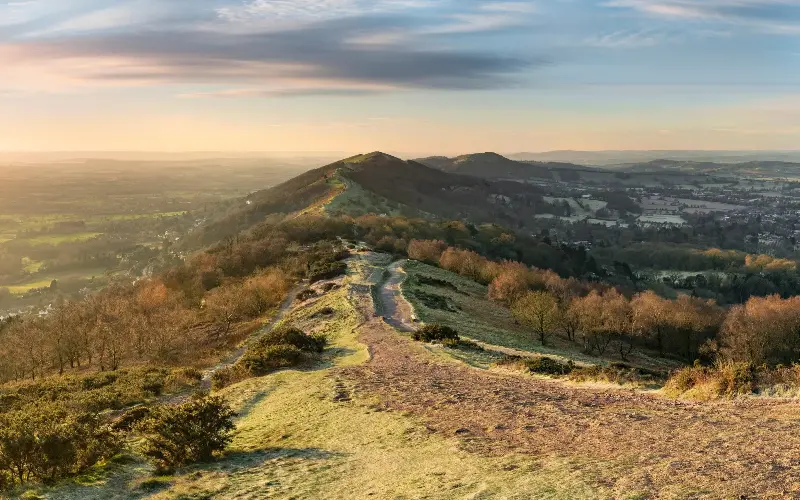
The scene from my window at Great Malvern’s Mount Pleasant Hotel is achingly English. Looking toward the Severn Valley, I watch the afternoon sun flare across languid green fields, while in the foreground a medieval parish church stands proudly as dense grey rain clouds hover ominously nearby.
The 17th-century diarist John Evelyn called the view from the 1,394ft-high summit of the Malvern Hills “one of the godliest vistas in England”, and it’s hard to argue. Often mist-strewn, and straddling the counties of Worcestershire and Herefordshire (plus a fragment of northern Gloucestershire), the hills are an eight-mile-long ridge running north to south with the hillside town of Great Malvern acting as its quaint and curious epicentre.
The Victorians flocked to this corner of the Midlands in their droves, convinced the newfangled “water cure” would solve all their problems. Or they’d get a rare hot bath out of it, at any rate. Charles Dickens loved visiting this salubrious spot, and 100 years later, during the 1950s, another British literary titan was just as enamoured. Though for JRR Tolkien, it was the landscape that profoundly affected him and he loved taking walks in the Malvern Hills.
Seventy years ago, in 1955, Tolkien published The Return of the King, the last of his epic Lord of the Rings trilogy, and he may well have been inspired by the Malvern Hills when describing some of the book’s most notable locations. Like all good authors, Tolkien never discussed his inspirations, leaving that up to his readers, but there are certainly some clues.
“The Severn runs north to south and that’s why the hills stick out so much,” says my guide for the day, Dan Johnson. “Towards Wales, there’s the Black Mountains in the distance. And it’s very similar to The Lord of the Rings when they’re heading to Mordor.”
Johnson once worked as a BBC sports journalist, but these days is an outdoor enthusiast, having given up the office to juggle various gigs in the elements, including working as a lifeguard. Clad today in sturdy caramel walking boots, navy shorts and a black Lord of the Rings T-shirt, his Tolkien enthusiasm is perfect for our walk in the author’s footsteps.
For the uninitiated, Great Malvern’s Church Street is on a serious gradient and we’ve barely reached the lofty Belle Vue Terrace before my thighs start feeling the strain. Mercifully, there’s a Victorian drinking spout pouring pure Malvern spring water piped directly from three springs above the town, Happy Valley, Rushey Valley and Ivy Scar Rock.
Refreshed, we stroll north along balcony-like Belle Vue Terrace and past the Unicorn pub. Dating back to the 16th century, it’s probably the oldest building in Great Malvern and was once used as a staging post between nearby Ledbury and Worcester. Tolkien loved walking with his great friend and fellow novelist CS Lewis, and this timber-framed haunt was their favourite spot for a post-walk pint.
“They were quite fussy about their pubs – Tolkien in particular,” explains Johnson. “He hated technology and he hated radios. This was back in the Fifties. So apparently, if they went into a pub with the radio playing, he’d turn around and walk out. They decided the pub they liked the best was the Unicorn, as it was quite old-fashioned and served beer in proper glasses.”
Unfortunately, I doubt Tolkien would enjoy the place in its current form. My visit the previous evening was soundtracked by the incessant bleeps and bloops of a gambling machine near the bar, while late-1980s Stock, Aitken and Waterman synth pop videos blared from the TV screen. Though it does have a crackling fire, a hallmark of any self-respecting rural pub.
Continuing on, we take a serpentine route on this crisp and sunny spring morning through the hillside suburbia of Link Top before looping around past the former homes of composer Edward Elgar and local headteacher George Sayer, a great friend of Tolkien’s with whom he would stay when visiting the town to walk the hills. With Lewis, the three of them formed something of a walking power trio, though in very different styles.
“Lewis liked to walk fast and build up a sweat, stomp on and push ahead,” says Johnson, as we walk through a thicket of tangled woodland up into the hills proper. “Tolkien was completely different. He liked to walk slowly and stop and point at everything, ‘What’s that plant? What’s that tree?’ He liked to ponder, but also talk a lot. He didn’t like to walk and talk at the same time. He’d always stop to make his point and throw his arms about and gesticulate, which drove Lewis mad.”
I always imagined novelists as the genteel type (with occasional exceptions, like Ernest Hemingway and Hunter S Thompson), insular and averse to any sort of physical exercise, but Johnson’s colourful descriptions of Tolkien and Lewis make me reconsider.
We power on past craggy cliff faces as buzzards hang in the air above, before coming to a high opening where Worcestershire fans out in front of us and the houses we walked by an hour ago now resemble distant Monopoly pieces.
As we circle around the track to the 1,302ft summit of North Hill, Great Malvern looks particularly handsome from above.
“The idea that The Shire, where the hobbits are from, is a nice, safe little place, is a bit like Malvern,” says Johnson as we put our bags down to admire the view. “Obviously other places claim they’re what The Shire was based on. But it’s certainly based around a small English rural town.”
After descending the 99 steps back down to the street level, there are plenty more reasons to stick around. Located down a narrow side street, the superb Carnival Records was named – to the surprise of almost everyone here – one of the best vinyl record shops in the world earlier this year. Heavy on the melted Montgomery cheddar, Belle Vue’s Faun plates up one of the finest cheese toasties I’ve ever had, while back on Church Street Weavers of Malvern pour a smorgasbord of local real and craft ales.
And for perhaps the most visceral experience of the hills, the nearby Morgan Motor Company offers the opportunity to take a windswept solo drive around the Malverns in one of their iconic hand-built sports cars.
But whether Tolkien took his inspiration from here or not, this tremendously underrated corner of England should be seen in person, and not simply read about.
How to do it
Direct return trains from London Paddington to Great Malvern start from £63 with Great Western Rail. Double rooms at the Mount Pleasant Hotel cost from £250 per night in season, and £112 out of season. James March was a guest of Visit the Malverns.
